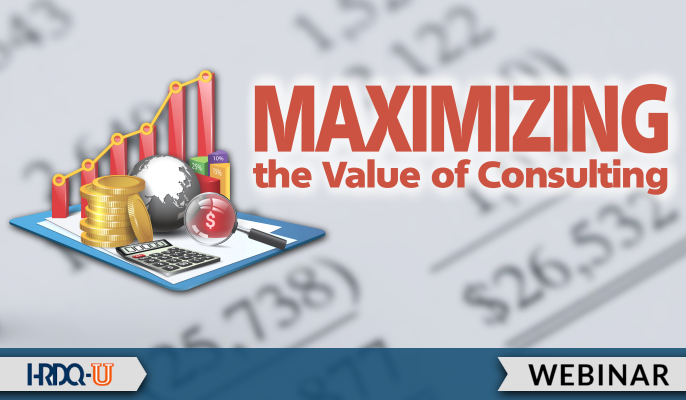- 827 Lincoln Ave. #B-10 West Chester, PA 19380
- support@hrdq.com
- +1-610-279-2002
Quick Links
Menu
Featured Topics
Menu
Total Results
We could not find what you're looking for. Please try again.No Record Found

The consulting profession is an essential contributor to most organizations. While consulting has grown steadily in recent years, more internal functions are being outsourced, creating additional demand for external consulting. Internally, organizations are creating opportunities for consulting expertise. At the same time, questions surround the value of the consulting process. Many top leaders ask external consultants to prove the value of their work and, in some cases, show the ROI before a project begins. Internally, consultants are struggling, because of the COVID-19 pandemic, with reduced budgets and eliminated departments.
Executives and sponsors need clear and compelling evidence that consulting makes a difference in terms they clearly understand and appreciate. This session will show participants how to manage the process to deliver value, be relevant in today’s environment, and calculate the value of consulting. Implementing these actions will ensure that a project is connected to the business, manages costs efficiently, and value is delivered (impact and ROI). This session demonstrates how to maximize the value of consulting.


The Bottomline on ROI
The Bottomline on ROI simplifies the process of connecting HR, learning, and performance improvement programs and projects to measurable outcomes. Through real-world case studies, skill-development exercises, and implementation strategies, you will gain the confidence to evaluate and report results.
Get 15% OFF with code CALCULATEROI at checkout!
Patti P. Phillips, Ph.D., CEO of ROI Institute, Inc., is a renowned leader in measurement and evaluation. Patti helps organizations implement the ROI Methodology®️ in more than 70 countries around the world. Since 1997, Patti has been a driving force in the global adoption of the ROI Methodology and the use of measurement and evaluation to drive organizational change. Her work as an educator, researcher, consultant, and coach supports practitioners as they develop their own expertise in an effort to help organizations and communities thrive. Her work spans private sector, public sector, nonprofit, and nongovernmental organizations.
Patti serves as a member of the Board of Trustees of the United Nations Institute for Training and Research (UNITAR). She serves as chair of the Institute for Corporate Productivity (i4cp) People Analytics Board, principal research fellow for The Conference Board, board chair of the Center for Talent Reporting (CTR), and is an Association for Talent Development (ATD) Certification Institute fellow. She also serves on the faculty of the UN System Staff College in Turin, Italy. Patti has authored or edited more than 75 books on the subject of measurement, evaluation, analytics, and ROI. Her work has been featured on CNBC, Euronews, and in more than a dozen business journals.
Connect with Patti on Facebook, Twitter, and at www.roiinstitute.net.
Training Tools for Developing Great People Skills
This event is sponsored by HRDQ. For 45 years HRDQ has provided research-based, off-the-shelf soft-skills training resources for classroom, virtual, and online training. From assessments and workshops to experiential hands-on games, HRDQ helps organizations improve performance, increase job satisfaction, and more.
Learn more at HRDQstore.com

“These webinars are really valuable and insightful – definitely worth attending.”
Sandra C.
Consultant
Fareport Training

“This was absolutely amazing. The context was phenomenal and extremely helpful and relevant. The presenter provided great value in the content as well as in the delivery. I wish there was more time. The user experience with the platform and the content is well worth the investment of time.”
Michael W.
Consultant
Runners With A Vision Enterprises

“Most impactful, actionable webinar I’ve attended in many years! Wonderful content [that is] presented in a pleasant and easy-to-understand style. Thank You!”
Keith G.
HR Member
East Tennessee State University

Sign up to be notified of upcoming live webinars, in-depth workshops, podcasts, blog posts, promotions and much more. Stay ahead of the curve and subscribe for FREE today!